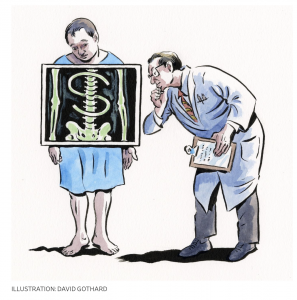Cancer treatment has come a long way from where it was in 1975 when I entered medical school. But success is still mainly dependent upon early detection. With early detection, the cure rate for many cancers is exceedingly high. Therefore, who wouldn’t want to improve our ability to detect cancers early?
Allysia Finley, writing for The Wall Street Journal, tells us of the dramatic case of Roger Royse, who was diagnosed with pancreatic cancer in July, 2022. But unlike most people, Royse was diagnosed in Stage II, with limited disease, instead of Stage IV. The five-year relative survival rate for late-stage metastatic pancreatic cancer is 3% – which means that patients are 3% as likely to live five years after their diagnosis as other cancer-free individuals. But if pancreatic cancer is caught before it has spread to other organs, the survival rate is 44%.
The trouble is that this cancer is almost never caught early. There’s no routine screening for it, and symptoms don’t develop until it is advanced. Mr. Royse, 64, had no idea he was sick until he took a blood test called Galleri, produced by the Menlo Park, Calif., startup Grail. He had surgery and chemotherapy and is now cancer-free.
Early diagnosis is the best defense against most cancers, as President Biden noted when he announced his Cancer Moonshot initiative two years ago. But only a handful of cancers—of the breast, lung, colon and cervix—have screening tests recommended by the U.S. Preventive Services Task Force, an independent panel that evaluates medical screenings.
Many companies are developing blood tests that can detect cancer signals before symptoms occur, and Grail’s is the most advanced. A study found it can identify more than 50 types of cancer 52% of the time and the 12 deadliest cancers in Stages I through III 68% of the time.
Naturally, it’s expensive. The test costs $949 and isn’t covered by Medicare or most private insurance. Mr. Royse, a lawyer who works with Silicon Valley startups, paid out of pocket for the test and follow-up imaging to confirm his cancer. Most Americans can’t afford to do so, and some public-health experts think that’s just as well. They fret that widespread use of multicancer early-detection tests would cause healthcare spending to explode. Those fears have snarled Galleri and similar tests in a web of red tape.
Mr. Royse learned about Grail’s test in April 2022 and asked his physician about it. “He said it was unnecessary, and you don’t have symptoms,” Mr. Royse says. A second doctor also refused to prescribe it. So Mr. Royse visited Grail’s website, which referred him to a telemedicine provider who ordered a test. Another telemedicine doctor walked him through his results, which showed a cancer signal likely emanating from the pancreas, gallbladder, stomach or esophagus.
An MRI revealed a suspicious mass on his pancreas, which a biopsy confirmed was cancerous. Mr. Royse had three months of chemotherapy, surgery and another three months of chemotherapy, which ended last February. Because pancreatic cancer often recurs, he gets CT and MRI scans every three months. In addition, he has signed up for startup Natera’s Signatera customized blood test, which checks DNA specific to the patient’s cancer and can signal its return before signs are visible on the scans.
Grail’s test has a roughly 0.5% false-positive rate, meaning 1 in 200 patients who don’t have cancer will get a positive signal. Its positive predictive value is 43%, so that of every 100 patients with a positive signal, 43 actually have cancer. That may sound low, but the positive predictive value for some recommended cancer screenings is far lower. Fewer than 1 in 10 women with an abnormal finding on a mammogram are diagnosed with breast cancer. Yet all women over 40 are advised to get regular mammograms.
What is hampering the widespread use of this new form of cancer screening?
More on that next post.


